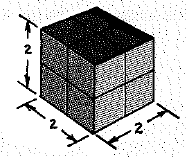
Consider eight one-cubic-centimeter sugar cubes stacked two-by-two to form a single bigger cube. What will be the volume of the combined cube? How does its surface area compare to the total surface area of the eight separate cubes?

Volume of the combined cube and total surface area in compare to separate cube.
Answer to Problem 49A
Volume of the combined cube is
Explanation of Solution
Given:
Number of small cubes,
Volume of a small cube,
Formula Used:
The volume of cube is,
Where,
The total surface area of cube is,
Where,
Calculation:
As volume of a small cube,
So, side of small cube is
Let the volume of the combined cube is
The volume of the combined cube will be equal to the volume of the all small cubes.
So,
And side of combined cube is
Now,
The total surface area of small cube is,
While the total surface area of the combined cube is,
So,
Conclusion:
Therefore, the volume of the combined cube is
Chapter 18 Solutions
Conceptual Physics: The High School Physics Program
Additional Science Textbook Solutions
Concepts of Genetics (12th Edition)
Campbell Biology (11th Edition)
Chemistry (7th Edition)
Organic Chemistry (8th Edition)
Chemistry: An Introduction to General, Organic, and Biological Chemistry (13th Edition)
Introductory Chemistry (6th Edition)
- Figure 8.14 shows a cube at rest and a small object heading toward it. (a) Describe the directions (angle 1) at which the small object can emerge after colliding elastically with the cube. How does 1 depend on b, the so-called impact parameter? Ignore any effects that might be due to rotation after the collision, and assume that the cube is much more massive than the small object. (b) Answer the same questions if the small object instead collides with a massive sphere.arrow_forward2. A projectile is shot from a launcher at an angle 0,, with an initial velocity magnitude vo, from a point even with a tabletop. The projectile hits an apple atop a child's noggin (see Figure 1). The apple is a height y above the tabletop, and a horizontal distance x from the launcher. Set this up as a formal problem, and solve for x. That is, determine an expression for x in terms of only v₁, 0, y and g. Actually, this is quite a long expression. So, if you want, you can determine an expression for x in terms of v., 0., and time t, and determine another expression for timet (in terms of v., 0.,y and g) that you will solve and then substitute the value of t into the expression for x. Your final equation(s) will be called Equation 3 (and Equation 4).arrow_forwardDraw a phase portrait for an oscillating, damped spring.arrow_forward
- A person is running a temperature of 41.0°C. What is the equivalent temperature on the Fahrenheit scale? (Enter your answer to at least three significant figures.) °Farrow_forwardWhat is the period of a rock of mass 2.0kg tied to the end of a spring 0.625m long string that hangs in a doorway and has an elastic constant of 40N/m?arrow_forwardGive an example of friction speeding up an object.arrow_forward
- Which is the higher temperature? (Assume temperatures to be exact numbers.) (a) 272°C or 272°F? 272°C 272°F They are the same temperature. (b) 200°C or 368°F? 200°C 368°F They are the same temperature.arrow_forwardWhat is the direction of a force vector given by ~v = −6Nˆi − 8Nˆj?arrow_forwardWhat can be said of the position vector of an object far from any influences on its motion?arrow_forward
- ་ Consider a ball sliding down a ramp as shown above. The ball is already in motion at the position 1. Which direction best approximates the direction of acceleration vector a when the object is at position 2?arrow_forwardPlease solve and answer the question correctly please. Thank you!!arrow_forwardPlease solve and answer the question correctly please. Thank you!!arrow_forward
 College PhysicsPhysicsISBN:9781305952300Author:Raymond A. Serway, Chris VuillePublisher:Cengage Learning
College PhysicsPhysicsISBN:9781305952300Author:Raymond A. Serway, Chris VuillePublisher:Cengage Learning University Physics (14th Edition)PhysicsISBN:9780133969290Author:Hugh D. Young, Roger A. FreedmanPublisher:PEARSON
University Physics (14th Edition)PhysicsISBN:9780133969290Author:Hugh D. Young, Roger A. FreedmanPublisher:PEARSON Introduction To Quantum MechanicsPhysicsISBN:9781107189638Author:Griffiths, David J., Schroeter, Darrell F.Publisher:Cambridge University Press
Introduction To Quantum MechanicsPhysicsISBN:9781107189638Author:Griffiths, David J., Schroeter, Darrell F.Publisher:Cambridge University Press Physics for Scientists and EngineersPhysicsISBN:9781337553278Author:Raymond A. Serway, John W. JewettPublisher:Cengage Learning
Physics for Scientists and EngineersPhysicsISBN:9781337553278Author:Raymond A. Serway, John W. JewettPublisher:Cengage Learning Lecture- Tutorials for Introductory AstronomyPhysicsISBN:9780321820464Author:Edward E. Prather, Tim P. Slater, Jeff P. Adams, Gina BrissendenPublisher:Addison-Wesley
Lecture- Tutorials for Introductory AstronomyPhysicsISBN:9780321820464Author:Edward E. Prather, Tim P. Slater, Jeff P. Adams, Gina BrissendenPublisher:Addison-Wesley College Physics: A Strategic Approach (4th Editio...PhysicsISBN:9780134609034Author:Randall D. Knight (Professor Emeritus), Brian Jones, Stuart FieldPublisher:PEARSON
College Physics: A Strategic Approach (4th Editio...PhysicsISBN:9780134609034Author:Randall D. Knight (Professor Emeritus), Brian Jones, Stuart FieldPublisher:PEARSON





